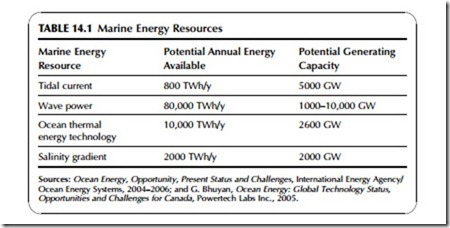MARINE ENERGY RESOURCE
To arrive at an estimate for the size of the global marine energy resource it is necessary to make assumptions about the actual amount of energy that each type of resource contains and the efficiency with which it can be extracted. Produc- ing such estimates can be a challenge for resources as widely distributed and as difficult to define as these, but attempts have been made. Some are shown in Table 14.1. The table contains figures for the annual energy that might be extracted from each resource based on figures from the International Energy Agency (IEA), and figures for the potential generating capacity each might yield, based on research from Powertech Labs.
The largest resource based on the IEA figures is wave power that could, in principle, provide up to 80,000 TWh of energy each year. OTEC is the next largest with a potential 10,000 TWh/year, followed by salinity gradient with 2000 TWh/year, and finally tidal current that could yield 800 TWh/year. Other estimates provide significantly different values so these should be used for broad guidance only. In terms of the generating capacity each might support, wave power is again the largest, potentially, with up to 10,000 GW. Tidal current might provide 5000 GW, OTEC 2600 GW, and salinity gradient 2000 GW. Based on these evaluations, even the smallest could potentially provide a significant contribution to global power generation.
Of the four resources, tidal stream has the smallest potential, but because the currents that make up the resource are located close to shore, it is perhaps the
Sources: Ocean Energy, Opportunity, Present Status and Challenges, International Energy Agency/ Ocean Energy Systems, 2004–2006; and G. Bhuyan, Ocean Energy: Global Technology Status, Opportunities and Challenges for Canada, Powertech Labs Inc., 2005.
easiest to exploit and so the generating capacity it might provide is relatively high. The existence of tidal currents depends critically on local topologies and some regions have much better regimes than others. The U.K. coastline is estimated to hold around 40 TWh/year, and in Alaska perhaps 100 TWh/year could be exploited.
There are other ocean currents that are not caused by the tides, such as the Gulf Stream that operates in the Atlantic Ocean. This could perhaps be exploited too using the technology for tidal stream energy capture. Estimates from Florida State University suggest that 8 GW of generating capacity could be installed to extract energy from the Gulf Stream as it passes the Florida coast. Capturing energy from the Gulf Stream in the deep ocean would be more difficult.
Waves are generated when the seas absorb energy from the wind. The longer the reach over which the wind can blow, the more energy is absorbed and the greater the wave energy available. As a consequence, the best wave regimes are found where prevailing winds can blow across long stretches of open sea. Once created, waves will travel long distances, and they contain more energy in deep water than in shallow water where they shed energy as they approach the shore.
The largest waves are usually found between 30o and 60o of latitude (hence the name ‘the roaring forties’ for the region in southern hemisphere where west- erly gales blow throughout the year), but there is also a good wave regime in some regions between 30o of latitude and the equator and also in southern polar waters. Regionally, the best locations for wave power exploitation are found on western coastlines along North and South America, in western Europe and western Africa, and the western coasts of Australia and New Zealand.
OTEC energy is found where seas absorb the heat from the sun. As a con- sequence, the greatest resource is in tropical regions in the seas close to the equator. Much of this thermal energy is far out to sea and difficult to exploit except with floating plants. Shoreline exploitation is possible, but to use the heat in coastal surface waters, an OTEC plant must also have access to deep, cold waters. A depth of a 1 km is generally needed to provide an adequate temperature difference between the hot and cold sources to drive an OTEC heat engine economically. Shore sites with deep offshore waters close enough to the shore to be accessible are rare.
To generate power from the mixing of fresh and salt water it is necessary to have a source of both close together. This situation can generally only be found at the mouth of a river. In principle, high-salinity seas such as the Dead Sea could also provide energy in this way, but exploitation would involve bringing in fresh water and diluting the saline source, which might have significant envi- ronmental consequences.
